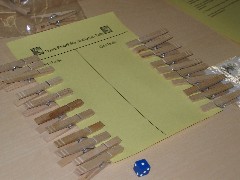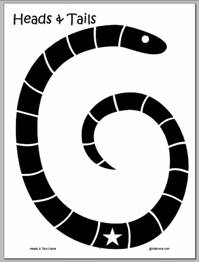Write each student's name on a clothespin. A piece of foam core board or laminated oak tag makes a great two-choice (Yes/No) graph board. Students simply affix the clothespin to the correct side to indicate their response. Students can easily "see" the results and count to verify the outcome.
- Use this method to record the results of informal classroom surveys:
- Literature: Which character do you like best? What do you think the character will do next? Which version of the story do you prefer?
- Daily Routines: Are you buying lunch or did you bring lunch? Present or Absent?
- Ask students to report the results of who won two-player games so that the class can analyze the fairness of the games.
In this game, each student places a penny on the star. One student is heads and the other student is tails. Students should place their pennies with the appropriate side up.
The heads student tosses a penny and moves a space toward the head if the outcome is heads. If the outcome is tails, the student does not move. Play repeats with the tails student, who moves only if his/her toss is tails, moving toward the tail of the snake. The first player to read the head or the tail of the snake wins. The winning player should add a clothespin to the graph to record the win as heads or tails.
Class discussion should focus on analyzing the data to determine if the game is fair or not. Directions and gameboard are included in the download. This game was developed by a Monmouth University student for the Probability Fair.
Download the Heads & Tails Game which includes the game mat, directions and icons for centers work boards. This game is an excellent addition to a classroom math center, as students may play with a partner and record the results for class discussion at a later time.




No comments:
Post a Comment